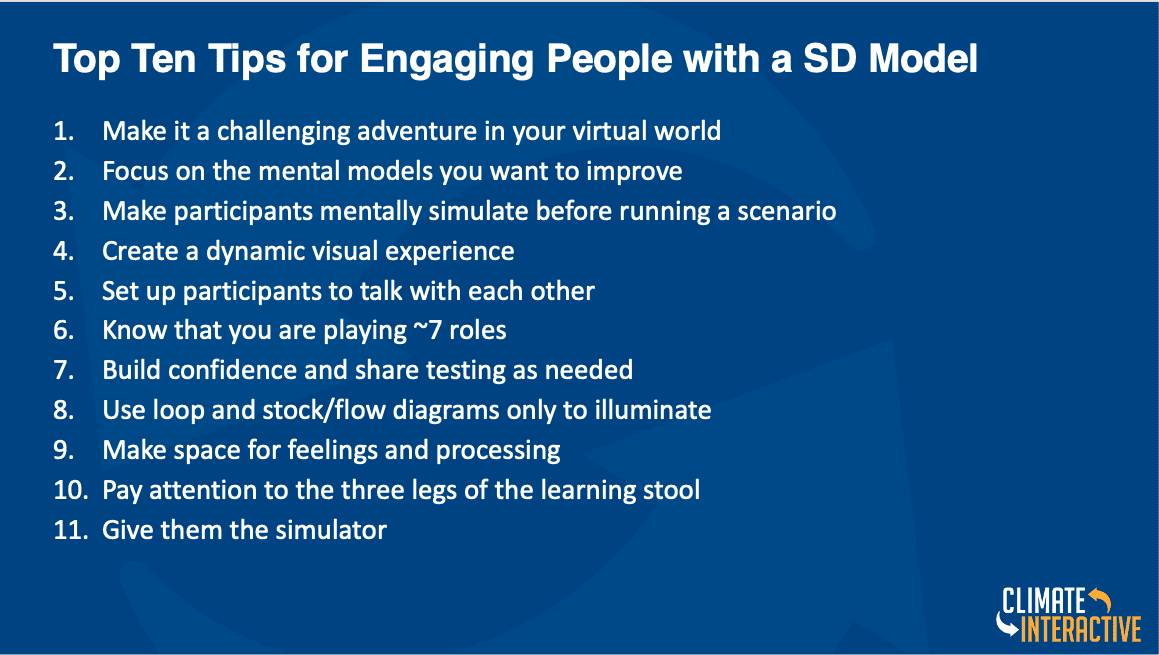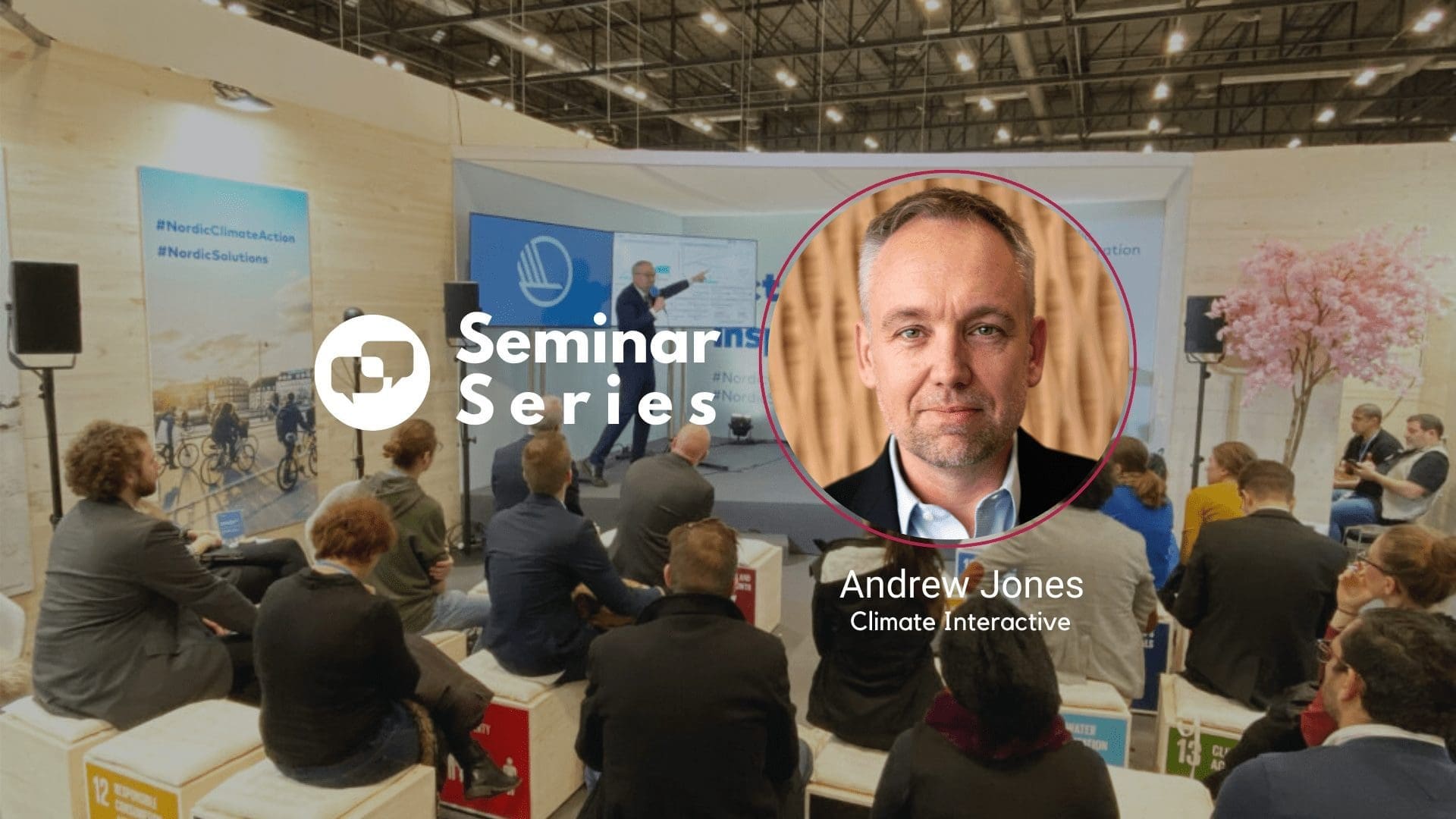Systems Thinking for Pre-College Education
Pre-College SIG Seminar Series consists of periodic online meetings on K-12 education to the Systems Thinking and System Dynamics communities. These virtual activities cover a wide range of topics on K-12 education from many subjects while bringing together academics, teachers, and students together for learning and lively discussion. Our seminars aim to promote and improve skills to effectively apply systems thinking and dynamic computer simulation to K-12 education. All seminars and recordings are free for both members and the general public.
Top 10 Tips to Engage People with a System Dynamics Model
Top 10 Tips to Engage People with a System Dynamics Model
Andrew P. Jones is Co-Founder and Co-Director of Climate Interactive and a Research Affiliate at MIT Sloan. Andrew is an expert on climate change and energy issues, a prominent System Dynamics modeler, and a keynote speaker.
In his webinar with System Dynamics Society, Jones presented his 10+1 tips to engage people with a System Dynamics model. Here’s a summary of the tips, but you can watch the recording below for all details!
All Seminar Series are free for members of the Society. Join us today and unlock all benefits!

1. Make it a challenging adventure on their terms in your virtual world
Make your model playful to entice curiosity about what it tests. This is a virtual world where people will experience something new. The challenging adventure or game is what we do mostly with the interface of the model. If you open the En-ROADS interface, you will see two main graphs, the main output, and several sliders. When playing with the sliders, your changes will be reflected in the graphs. Avoid telling people: “I’m going to show you how to do this”, instead, try saying: “On your terms, you’re going to have to figure out how to get that graph down to your target line”
“We do NOT model systems. We model problems.
2. Focus on mental models you want to improve
We do NOT model systems. We model problems. In System Dynamics, we define a problem as a behavior over time, a reference mode that we’re curious about why does it behave like that. We’re so curious about the problem that we develop a simulation to understand it. We build interfaces to improve the mental models of the stakeholders or clients. System Dynamics modelers know that mostly the mental models of decision-makers don’t match with the real world and how the actual system behaves. We don’t build interfaces to give access to policy levers in the system, but we are trying to leverage the necessary mental model improvements.
3. Make participants mentally simulate before running a scenario
If people don’t have a theory, they don’t notice the mental model they use to forecast what’s going to happen. Then they don’t get to learn and improve their understanding. Therefore, you must encourage people to anticipate, based on their own theories, what’s going to happen when running a scenario. No theory, no learning.” (Edward Deming)
“Tell people what to look at, let them guess what they are going to see, and then make it exciting like a movie”
4. Create a dynamic visual experience
Humans like to see change and it is important to employ this fact to get people to run and look at your graphs without losing their focus. Make people think and anticipate and then direct their eyes to what you want them to notice. If you do this well, you don’t even need to draw a Causal Loop Diagram because they are drawing it in their heads. Tell people what to look at, let them guess what they are going to see, and then make it exciting like a movie.
5. Set up participants to talk with each other
People learn socially and with hot-button issues like climate change, they need to know that their friends are not going to hate them if they change their minds. You need people to be processing the information collectively and socially with others. When presenting your model, stop frequently and advise: “Turn to the person next to you and discuss what you think of that conclusion”.
“Keep the discussion on improving system performance not on the tool you’re using”
6. Know along the way that you are playing at least seven roles
Try to present your model with the help of, at least, another person. Ideally, you need someone to facilitate the discussion while another runs the model. As a facilitator, you will be playing four roles including:
Coach – Helping participants to extract insights out of the model.
Professor – Teaching the audience theories and sharing factual information
Playwright – Creating an emotional journey of ups and downs.
Fellow Traveler – Being authentic, vulnerable, and just another person trying to solve a complex problem. If it is worth making a model about, it’s very important. If it is very important, you must deeply care about it.
You want the conversation to be around how to solve a complex problem together and what your audience is going to do about it. Keep the discussion on improving system performance not on “oh that’s a cool model how did you make that”. That’s all side information.
You want to minimize your roles in:
Tech – you must keep the conversation on improving the system performance, not the way or tool you have used to develop the model or create the graphs
Advocate – when people disagree with you, your job is not to fight them or disagree with them back, but to set up others to find the voice of your work.
Defender – Don’t get involved in the fight of “YOU HAVE A BAD MODEL!”. Avoid this fight as much as you can.
Read the article “Teamwork in Group Model Building” on the System Dynamics Review for more insights on strategies for efficient and effective model building in groups.
7. Build confidence and share testing as needed
You can share your tests and comparisons to other models and/or predictions to build stronger confidence. For instance, Climate Interactive and MIT Sloan built the En-ROADS with the best science available, using the data sources such as the Intergovernmental Panel on Climate Change (IPCC) and International Energy Agency. All the assumptions are available open-source in the 400-page reference guide. Many of the assumptions that someone might not believe in are changeable within the model. Several models do not have good literature of other scenarios to compare against, while En-ROADS can be compared with six integrated assessment models to build confidence.
8. Use loops and stock/flow diagrams only to illuminate
As you help people improve their intuition, sometimes you need to use loops and stock/flow diagrams, especially if you are presenting to a more technical audience but always connect it to the simulator. Avoid showing this to policymakers, they are usually not interested in the loops, instead, tell a story about reinforcing or balancing feedback.
9. Make space for feelings and processing
Deliver your presentation with excitement and intensity, but you need to slam on the brakes and let participants compromise with their feelings and do the necessary processing. You may create a scenario of success, and they get to create their vision, something that they would love to see. And it’s time to slam on the brakes and may invite them to 60 seconds of silence. Yes! It is weird but imagine 60 seconds of silence of people sitting with a scenario of success.
“Create the conditions where people are open to changing their minds”
10. Pay attention to three legs of the learning stool
Reflective Conversation – Create the conditions where people are open to changing their minds, surfacing and testing assumptions, and talking to their peers about improving their assumptions. You’ve got to make the space where people are open to being wrong and thinking differently.
Vision – Help people see a future that they fall in love with they just want it so badly that they see the gap between the vision they want and the reality that they feel and experience that tension in between. Orient towards what one genuinely cares about.
Systems Thinking – Explaining how a complex system works where time, cause, and effect are distant in time and space can be difficult, especially when you include stocks, flows, feedback loops, and other inner relationships. You can learn how to facilitate a training that uses systems thinking and System Dynamics for free with Climate Interactive learning resources
10 + 1. Give them the simulator
People need your help as a facilitator, but you must give them something to play with that naturally gives them the mental model improvements that you want and guides them towards committing themselves to action to improve system performance. As Buckminster Fuller states “If you want to teach people a new way of thinking, don’t bother trying to teach them. Instead, give them a tool, the use of which will lead to new ways of thinking.”
Watch the recording below
Recent Posts
From Bergen to Global: UiB’s System Dynamics Group
From Bergen to Global: UiB’s System Dynamics Group The System Dynamics Group, an autonomous research group at the University of Bergen (UiB) was established in 1971 by professor emeritus Svein Nordbotten. Inspired by the work of Jay W. Forrester, Nordbotten...
Consideo’s Insight into the Global Energy Transition: A Systems Perspective
Consideo’s Insight into the Global Energy Transition: A Systems Perspective Complexities of Energy TransitionThe global energy transition is a complex challenge. The development of technology, the need for resources, the depletion of high-grade materials and...
A Digital Twin Business Model in 40 Hours
A Digital Twin Business Model in 40 Hours Though long past the date when I should have ‘retired’, I just can’t resist interesting projects, like the one a new friend brought me a few weeks ago. It concerns a small but fast-growing B2B business,...
Upcoming Events
Recent Business cases
Solving Bottlenecks in Dairy Production Facilities with System Dynamics
Solving Bottlenecks in Dairy Production Facilities with System Dynamics EXECUTIVE Summary FrieslandCampina faced potential bottlenecks in production due to the merging of two factories. They hired SD&Co which employed system dynamics simulation models to predict...
A Design Value Calculator: A System Dynamics Boardgame
A Design Value Calculator: A System Dynamics Boardgame EXECUTIVE Summary Product design is a specific form of complex innovation that touches all areas of an organization’s management. While entrepreneurs recognise the value of design, they often tend to focus...
The World Bank Uses System Dynamics to Identify Root Causes of Poverty
The World Bank Uses System Dynamics to Identify Root Causes of Poverty EXECUTIVE Summary Madagascar has one of the highest poverty rates in the world. In 2022, an astonishingly three out of every four people in Madagascar lived below the poverty line. Poverty has...







